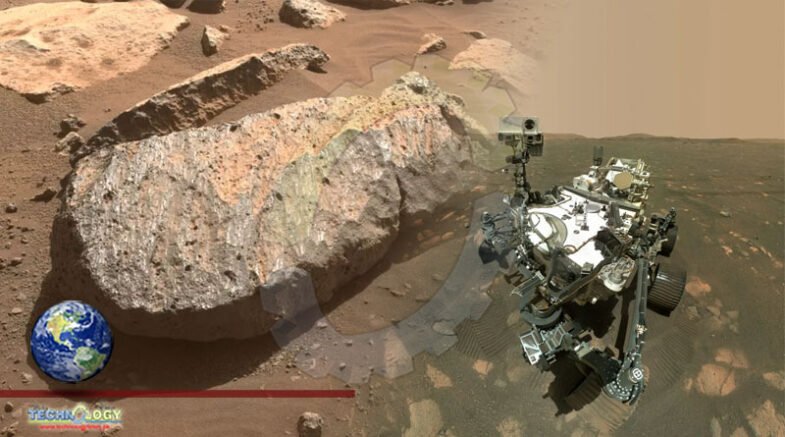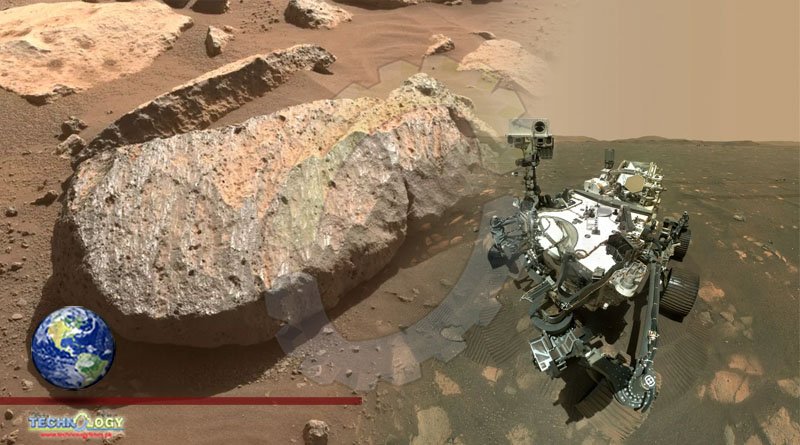NASA’s Perseverance rover will cache this pristine sample and others for return to Earth, which will “change everything for Mars soil science.

With the whirr of a drill, a robotic geologist some 244 million miles away just made history, collecting the first sample of Mars Soil Science for return to Earth. Sealed in an airtight, ultraclean tube, the sample is an important milestone in a multibillion-dollar effort to finally answer the question: Was there ever life on the red planet?
The successful manoeuvre by NASA’s Perseverance rover comes after the first sampling attempt failed last month when a weak, weathered rock on the crater floor crumbled to pieces. This time the team tried at a different spot, nabbing a finger-size cylinder of more durable rock from a boulder along a nearly half-mile-long ridge at Mars Soil Science.
“For all of NASA science, this is truly a historic moment,” Thomas Zurbuchen, NASA’s associate administrator for science, says in a press release.
The process wasn’t without its hiccups, though. While early images showed the tan, speckled rock nestled within its tube, the sample vanished from sight after the rover shook the tube to clear any dust. An extra day of analysis revealed the prize had simply slipped deeper inside the tube, which Perseverance rover then safely capped and stowed in its belly.
This sample is only the first of dozens to be collected in the coming months. The rover will ultimately deposit its cache on Mars’s surface, and a future mission will scoop it up and transport the rocks to eager earthbound scientists.
“It feels kind of surreal,” says Vivian Sun of NASA’s Jet Propulsion Laboratory (JPL), who co-leads the mission’s first science campaign. “What we’re doing right now is going to impact Mars science for a long time about Mars Soil Science.”
In addition to sampling, Perseverance rover is equipped to sniff, taste, and peer at the Martian landscape in greater detail than ever before, helping scientists unwind the planet’s watery past and seek out hints of Martian microbes that may have once thrived in now-vanished rivers and lakes. The stage for this dramatic search is Jezero Crater, a 28-mile-wide basin carved by a meteorite impact billions of years ago.
Perseverance rover touched down near the crater’s rim in February 2021 after a harrowing, seven-minute plunge through Mars’s thin atmosphere. Though the ground under the rover’s six wheels is now parched, the ruddy rocks and sand hold clues to a past flush with water. The science team will explore this region with the rover’s advanced suite of instruments, selecting samples from the crater floor up through an ancient river delta and beyond.
“We are going to be surprised,” says Nina Lanza, a planetary scientist and team lead for Space and Planetary Exploration at Los Alamos National Laboratory. “We are going to learn things that we never could have imagined.”
Jezero’s geological intrigue
Scientists believe Mars was once blanketed in a thick atmosphere, which helped trap enough heat to keep water from freezing and produced enough pressure to stop the liquid from evaporating and escaping as gas. But at some point the atmosphere thinned, and Mars’s climate took a dramatic turn. By three billion years ago, the planet was parched, and Mars became the red dustball we see today about Mars Soil Science.
Exactly why and how this happened remains unknown. Jezero’s rocks offer a chance to study this dramatic transformation, capturing the key slice of time during which the great drying took place. “As we explore different parts of the crater inside Jezero, we have the potential to kind of step through time,” says Kathryn Stack Morgan, a deputy project scientist at NASA’s JPL.
Jezero is a crater within a crater. The planetary pockmark is perched on the western edge of the Isidis Basin—a sprawling crater about 750 miles wide blasted out by a huge space rock some 3.9 billion years ago. A later impact sculpted the inner rocky bowl now known as Jezero. Then came the water.
Winding rivers spilled over the crater rim, feeding what became an ancient lake. The water slowed as it poured into the basin, causing suspended sand and mud to settle to the lake bottom and form a pair of deltas, which fanned out around the branching waterways.
The rover will explore the dried remains of the crater’s larger delta, which is cradled in Jezero’s western edge. This delta’s rapid buildup of sediments could have readily buried and preserved signatures of life—if it did exist—before the rivers dried up roughly 3.5 billion years ago.
A breach in the rim opposite this sandy fan, known as Pliva Vallis, marks where water once flowed out of the lake. The presence of both an entry and exit suggests that the lake waters were constantly refreshed, preventing salts from building up to levels that could have been harmful to many forms of life, and perhaps making Jezero prime real estate for microbes to thrive.
“As a geologist, I can’t help but get excited for understanding Mars Soil Science history,” says Bethany Ehlmann, a planetary scientist at the California Institute of Technology.
“Poorly behaved rock”
To collect Jezero’s geological bounty, Perseverance’s rover sampling system is composed of a trio of robots that work in tandem to drill cylinders of rock, seal them in airtight tubes, and deposit them into a storage rack within the rover’s belly. “It’s a spacecraft within a spacecraft,” says Ian Clark, a systems engineer at JPL who is part of the Perseverance team.
During Perseverance rover first sample attempt, the rover targeted an interlocking mosaic of light red-brown stones that make up swaths of the crater floor—perhaps the oldest rocks the rover will find in Jezero. Hints from orbit and the rover’s analyses on the ground point to a volcanic origin for these “paver stones,” as the team calls them. If that’s the case, returning these rocks to Earth would allow scientists to precisely date them using radioactive elements, helping piece together the region’s complex past.
But the first sampling attempt left the team empty-handed. While the rover’s sampling system initially seemed to work as planned, the sealed tube remained empty. Later analyses suggested that the rock’s interaction with ancient water whisked away much of the geological glue binding it together, which caused the sample to crumble to bits under the coring drill’s percussive strikes.
The team hasn’t given up hope for sampling the crater floor, and they plan to eventually look for less weathered paver stones to drill, Ken Farley, a Perseverance project scientist, writes in a blog post.
But for their second and most recent drilling attempt, the team directed the rover west to search for rocks “as different as possible” from the paver stones. The rover zeroed in on a boulder on top of a nearly half-mile-long ridge called Artuby. Standing tall above the landscape, the boulder appears to have resisted eons of battering, which suggested it’d be tough enough to withstand drilling.
The sampled boulder appears similar to other rocks poking up from the crater floor, sometimes called “high-standing rocks,” says Roger Wiens, a planetary scientist at Los Alamos National Laboratory and principal investigator of Perseverance rover SuperCam. Early on, the team planned to sample one of these high-standing rocks as well as the paver stones. “But we wanted to start with what we thought would be the easiest, which would be the softer ones—and, uh, oops,” Wiens laughs.
Now the newly stashed core confirms that the first sample was “just poorly behaved rock,” as Farley suspected, rather than an issue with the rover’s mechanisms for drilling and storing the cores of Mars Soil Science.
Collecting more samples—and sending them home
With the first sample safely stowed, the rover will soon double back east and then move northward to the delta, studying the rock formations along the way. One type of feature that scientists are eager to scrutinise is finely layered rock. Such laminations can be found on Earth in sediments deposited by water, wind, or sometimes volcanoes.
In water, laminations accumulate from the slow deposition of mud one layer at a time, which could have preserved traces of life in Jezero, as well as the chemistry of the now-vanished lake—providing “a true archive” of the conditions in which the rocks formed, says Keyron Hickman-Lewis, a geobiologist at the Natural History Museum in London and a return sample scientist on the Perseverance rover mission.
Layers are common in deltas, including the one in Jezero, but the rover also spied promising laminations in rock units on the crater floor. At a July 21 press briefing, Farley pulled up a picture of a crater floor deposit that looks like an uneven stack of brown papers. “This is exactly the kind of rock that we are most interested in investigating,” he said. But scientists are still working out what processes formed these rocks, whether they’re sediments, volcanics, or a mix of both, Wiens says.
Up on the delta, two other attractive targets are clays and carbonate minerals, which Caltech’s Ehlmann and her colleagues first spotted in Jezero using orbital data more than a decade ago. On Earth, carbonates often have close ties to life and can preserve exquisite structures, such as the finely wrinkled layers of ancient microbial mats known as stromatolites. Clays can rapidly entomb organic material, and if any exists on Mars, they may be shielding it from the destructive cosmic radiation that blasts the planet’s surface.
Another intriguing possible target for study is manganese-rich rocks. Manganese minerals can form in many ways, but microbes sometimes have a hand in the process.
Los Alamos’s Lanza and her colleagues suggested in a recent study that cyanobacteria could produce manganese-rich varnishes that commonly coat rocks found in deserts around the world. The microbes may use the minerals as a sort of sunscreen, protecting themselves from harsh ultraviolet radiation.
Manganese was previously spotted on Mars in nearby Gale Crater, where the Curiosity rover is busy with its own investigations. The team thinks they might have found some in Jezero too, but they are still working to confirm its presence and determine how much is there. Manganese on Mars can come in many forms and may create a similar veneer on rocks within the crater.
“If we see anything that’s like rock varnish, we really should stop and take a closer look,” Lanza says.
Finding life as we know it
Once dozens of samples have been collected and cached, another mission will have to land on the planet to pick them up. NASA and the European Space Agency are designing a lander equipped with a “fetch rover” that could launch as soon as 2026.
A small rocket on the lander would carry the precious rocks into orbit around Mars, where an orbiter would grab them and take them back to Earth, releasing the samples in a small probe that will crash land in the Utah desert.
After the samples are safely back to earth, scientists will use sophisticated tools to unlock any secrets held within the rocky remnants. But even then, steep challenges lie ahead in the search for ancient alien life. Experts debate what kind of evidence would be enough to identify extremely early life-forms, even on Earth. Claims of life that existed billions of years ago on our planet have driven multiyear feuds and cut schisms between scientists.
Source National Geographic
